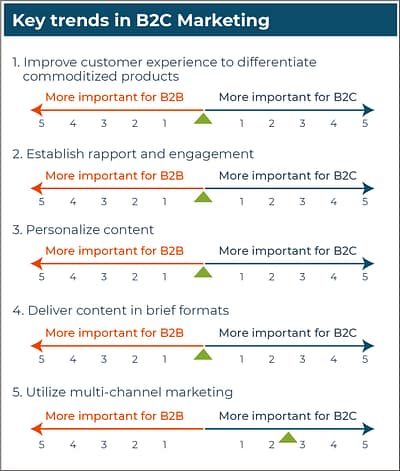Is B2B to be B2C? That is the question.
Marc Brown, who analyzes digital marketing strategy, trends and practices at Gartner, argues persuasively that the differences between B2B and B2C are are rapidly disappearing. This trend has important implications for sales and marketing video production, and for content marketing in general. And it supports the case for new types of video for technology marketing: video that improves the customer experience.
The commoditization of products
I’ve loosely paraphrased and simplified the disappearing differentiators cited by Brown in the form of hypothetical survey questions. The big driver of customer experience in B2C these days is commoditization. Consumers don’t see much difference between brands and product until they interact with them.

Commoditization is not a term used by Brown, but that’s what he’s talking about when he observes that customers “aren’t interested in ‘market leading’, ‘state of the art’, or ‘best in class’.” These phrases imply that the differences among competing products are actually pretty hazy. The rapid growth of sales enablement, account-based marketing, and similar technologies to keep up with customer wants and needs is evidence that customer experience should be increasingly important for B2B marketers.
If your product is perceived as a commodity, why would anyone watch a video about it? Yet product-centric videos are the norm in B2B. Brown refers to product-centric content as “corporate selfies.” A typical technology product video promises to deliver capabilities like visibility, scalability, and security to achieve productivity, cost savings, and customer satisfaction.
You have to ask yourself, how different from these are our competitors’ promises? If the customer can’t distinguish your features and benefits from the ones promised by your competitors, shouldn’t you be looking for new types of video that deliver what customers are looking for? As Brown puts it, “they’re looking for ways to be more effective at their jobs, save time, and avoid pressure from their management team.”
Establishing rapport
Salespeople need digestible, relevant content for effective engagement with customers over the course of a long sales process. Certainly, some of this content should be video — even if it’s just an animation that makes a diagram in a white paper come alive.
Personalize the customer experience
If you’re trying to deliver a personalized customer experience, you need to be able to reach out with a variety of different types of content at different times. A new type of video for technology marketing you might consider is a “simple story” video.” This is developing videos the way it’s done in agile software development, where product managers build applications around very simple stories about what the user really wants to do. “As a user, I want to do X in order to achieve Y.”
In software development, your goal is to deal with a set number of stories in, say, one week. Using video resources in the same way, telling one simple story this week, and another one next week, is an opportunistic way to build a library of videos that can be used to personalize the customer journey. You’re just trying to get your point across, not make an “explainer” or a “thought leadership” video. The video itself needn’t be personalized (though there are lots of ways to do that). It just needs to be relevant — the sales rep can supply the personalization in an email linking to the video.
Digestible videos
The way to make videos shorter is to limit the number of messages. This is a good idea in any case, since only 53% of viewers watch short videos (under 90 seconds) all the way to the end.
Video formats that customers haven’t seen before are likely be more engaging than product videos. How about
- Personalized message from a subject matter expert
- The key point of a blog post
- Executive summary of a research report
- Animated diagram of a use case
- Snippets from tutorials (see how easy this operation is)
Multi-channel marketing
In modern consumer marketing, brands try to give customers what they want before they ask by staying connected across all “touchpoints” from the browser, to the call center, to the smart phone in the car on its way to store, to the in-store kiosk, and the store associate’s tablet. This is less critical for complex solution selling (most B2B videos are still watched on desktops). Still, it’s good to keep in mind how and where videos are watched.
- in social media, videos are likely to be watched with the sound off.
- On mobile devices, interactive features, such as clickable chapter headings, aren’t well supported
- People are more likely to scroll past videos that don’t have informative poster frames
Make your point
Thinking up new types of video in the context of the customer experience is actually pretty easy. Getting these videos produced takes work, but the videos themselves need not be big productions. They just need to be well targeted, well-written, and to-the-point.




